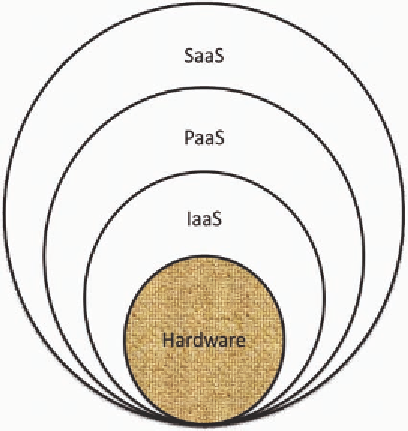Information Technology Reference
In-Depth Information
office productivity tools. The Cloud ecosystem
involves vendors, partners and end-users of the
Cloud Computing environment. Cloud partners
provide value additions to what the vendors have
to offer to the end-users. Some of the tools in
each of the XaaS areas are summarized in Table
1. More details about the specific tools and their
place in cloud computing can be obtained from
sources listed in the additional reading section at
the end of the chapter and from (Lenk et al. 2009).
The Cloud Computing ecosystem makes it
suitable for use from thin clients such as mobile
devices. As indicated in the section titled Future
Directions, towards the end of this chapter, Mobil-
ity is bound to be a key driving factor for Cloud
Computing. A good discussion of cloud comput-
ing for mobile users is given in (Kumar and Lu
2010). Energy savings, according to the analysis
alluded to in the article, depend on B (Bandwidth),
C (Cycles of Computation), and D (Data to be
transmitted). The Cloud Ecosystem helps with C
and D, assuming that most of the data is already
stored in the cloud and the mobile device only
needs to pass a pointer to it for the computation
to take place.
VIABILITY OF CLOUD
AS A COMPUTER
In this section, we talk about the issues contro-
versies, and problems facing Cloud Computing
and discuss possible solutions. The very enabling
factors for Cloud Computing can also become
limiting factors, as we shall see below.
Table 1. Service Models and Sample Tools Offered
in Each Layer
Economic Viability of the
Business Model
SaaS
PaaS
IaaS
Google Docs,
WebEx, Sales-
force.com
Google App Engine,
Microsoft Azure,
Django, Coghead
(acquired by SAP)
Amazon EC2,
GoogleFS,
Google BigTable
It can be easily seen that buying computing power
by the hour is more expensive over a long run than
owning the same equipment for the same period
of time. Otherwise, Cloud Providers will go out
of business. What then, is the rationale behind
the utility computing that the cloud stands for?
Will the rationale suffice for the business model
to be viable in the long run? After all, utility
computing did exist a few decades ago, when
computing power of the mainframes was rented
by the hour. Affordable desktops and personal
computers changed it all. The trend changed from
centralized computing to distributed computing,
owing to the drastic and non-uniform advances
in technology. For instance, computer networking
grew at a much faster pace than other hardware
and software technologies until a few years ago.
This non-uniform growth of the computing areas
caused a shift in business models.
Though the trend is still for technologies to
shrink costs, the shrinkage continues to be non-
Figure 1. Cloud Layers











Search WWH ::

Custom Search